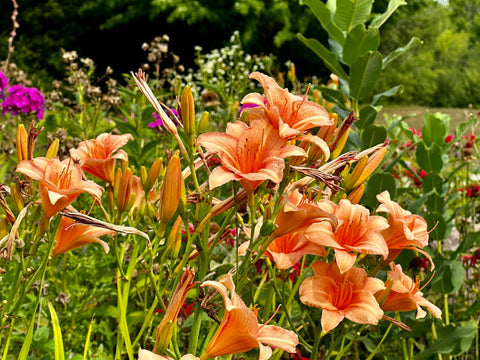Edible Flowers: Delicacies Readily Available From The Garden

By Veronica
Some edible flowers are very well-known and popular, such as the nasturtium. The vividly coloured flowers are edible and also the leaves will add a kick to your summer salads. They are incredibly easy to grow, so perfect for the beginner and children. They thrive in poor soils and are forgiving for the forgetful minder. They are favoured by pests in the garden, especially the white butterfly’s larvae and the blackfly. Therefore, they are very useful around brassicas and roses. Do not to worry, however, as they are vigorous, so there will be plenty to share. Choose from short varieties like the maharajah mix, for the front of the border or pots, or tall ones, used as climbers to make a fiery back drop.

Nasturtium - Photo by Anthony Rae
In the same colour tones, the calendula will add colour to your dishes. You can eat the petals, raw in salads. You may also dry the flowers to make an oil, a real treat for sensitive skin. Last but not least, they make great cut flowers for you to bring the bright oranges and yellows indoors. Growing to 50-60cm high on average, they are ideal in the middle of the border and look great in the midst of ornamental grasses like the ponytail grass.

The calendula, just like the nasturtium, self-seeds readily if you allow it, therefore, giving you colour in the borders for years to come.
For purple and blue hues, try the Love in a mist ‘Miss Jekyll’ (Nigella Damascanus). Used for its aromatic seeds essentially, the sky blue petals are edible too, preferably in small quantities. They will be perfect in the front or middle of the border as they grow to 45 cm, forming a feathery cushion. You may also enjoy its gorgeous scent in a pot by the door or in an informal window box.

In shades or purple again, the slightly taller borage provides purple or white flowers along with edible and nutritious leaves. Packed with vitamins and minerals, they are preferred cooked to soften the texture and removed the prickly coating. They are floriferous, and will keep on producing flowers all summer long.

These four varieties are very easy to grow and can be sown directly outdoors limiting the amount of effort put in to get beautiful flowers at a very low cost.
The violas, on the other hand, look fantastic on the plate. They might be a little trickier to grow, only because they need to be sown indoors, meaning that you will need to repot them and harden them off before planting them in their final position. You can also buy plugs in trays ready for planting, however, growing from seeds is the only way to be sure that they are chemical free. They are great for containers or the front of the border since they are short. Each new batch will give you about 4 months of blooms and can be grown nearly all year round. Keep deadheading to encourage further flowering. The violet is the sweetest and the best for flavour. Viola odorata is quite hard to come by however.

Violas - Photo by Yoksel 🌿 Zok
On the perennial side, the daylily (Hemerocallis) is absolutely delicious fried or raw. Be mindful not to mistake with other lilies which are poisonous! The daylily is clump-forming perennial that has strappy leaves unlike the bulbous, true lily. They also flower longer. Each flower lasts only for a day but is quickly replaced by others, continuously, throughout the Summer. They come in a wide range of warm colours, from white to burgundy and look very good with other perennials in the same colour hues such as geums or rudbeckias, but also with fennel for contrasting foliage texture.

Daylilies - Photo by Ted Balmer
Finally, the queen of them all, the rose. Use the petals fresh or dry, in drinks, desserts or cosmetics. They are versatile and sort of do-it-all. As for the taste, it is simple, they taste like they smell, gorgeous. Darker varieties tend to have a stronger taste. Whether you need a climber to dress a wall or an arch, a small variety for a container, a bush for shade or an informal hedge, there is a variety that will work for your garden and give a touch of luxury to your dishes.

Roses - Photo by Al Soot
The list does not end here, we can add cornflower, marigolds, and of course, flowering aromatic herbs like thyme or chamomile. They are surprisingly easy to grow, cheerful in the garden and the plate, and a treat for the palate. Give it a try and make your dishes more colourful.




Leave a comment